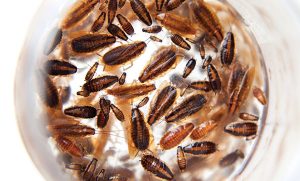-
In a healthy population, German cockroaches (Blattella germanica) will show about a 4:1 ratio of nymphs to adults.
-
At the end of a successful control program, the last cockroaches to be seen will be nymphs.

It’s helpful to record the total number of cockroaches caught and the ratio of nymphs to adults.
(PHOTO: ISTOCK .COM/PUNKBARBY)
Theoretically, there could be just one cockroach, but that’s not an infestation. It’s just a cockroach. Once there are multiple adults of mixed sexes that are actively reproducing, an infestation exists.
German cockroach populations can grow at an astounding rate when conditions are optimal. This is due largely to their high reproductive potential. A female cockroach will produce four to eight egg capsules in her adult life. Each egg case yields about 35 nymphs, which mature in about six to eight weeks. Normally, half the young will be female and they will begin reproducing as well. In a growing population, the mature females will produce an egg capsule every three weeks or so — and you can see how things can get out of hand fast.
When an infestation is discovered in an account, use the number of nymphs to adults to help characterize the population. Like many pests, a small number of individuals usually goes unnoticed. After nymphs from the first egg capsule or two become adults, there may be too many to hide. At this stage, insect monitors may show more adults than nymphs, or at least nymph ratios much less than 80 percent. If the population goes unchecked and new egg capsules are produced, the trap catch in the weeks to come is likely to swell up to 10 times as many nymphs. Baiting efforts, if done properly, will result in a decreasing ratio of nymphs. As the population declines, the trap catch will typically dwindle until only a few nymphs remain.
Of course, this isn’t a hard rule. While total trap catch goes down, the ratios can vary widely for any given week. It isn’t unusual to find a monitor with a female bearing an egg case and up to three dozen nymphs that have emerged since she was trapped.
If you record the total number caught and ratio of nymphs to adults, however, you can track the population as it crashes. This can be very helpful as you discuss with the facility what conditions exist and how a cooperative effort can shorten the time to elimination. Sanitation removes food sources and causes the cockroaches to range ever farther for food — increasing the likelihood they will feed on bait. It isn’t just sanitation, but the removal of protein and carbohydrate food sources that yields the greatest benefits. Developing cockroaches cannot thrive on a diet of grease.
Keep in mind, trap catch data is most valuable when there are a sufficient number of monitors that stay in the same locations and are checked at regular intervals. Otherwise, the numbers can become confusing.
Contributor Mark Sheperdigian, BCE, can be reached at shep@rosepest.com.
Leave A Comment